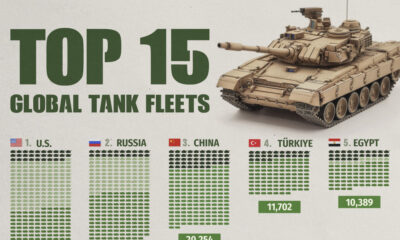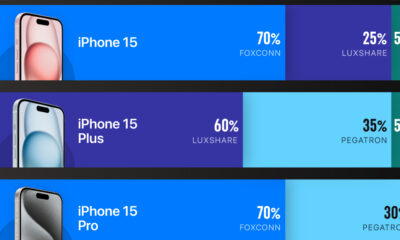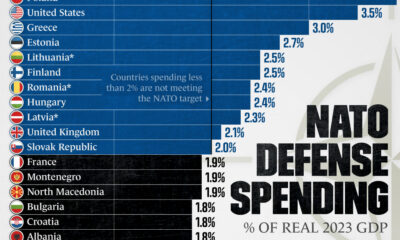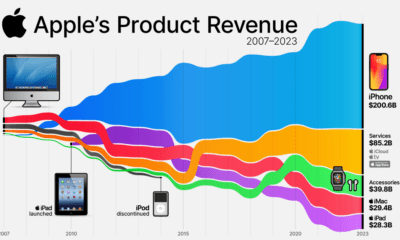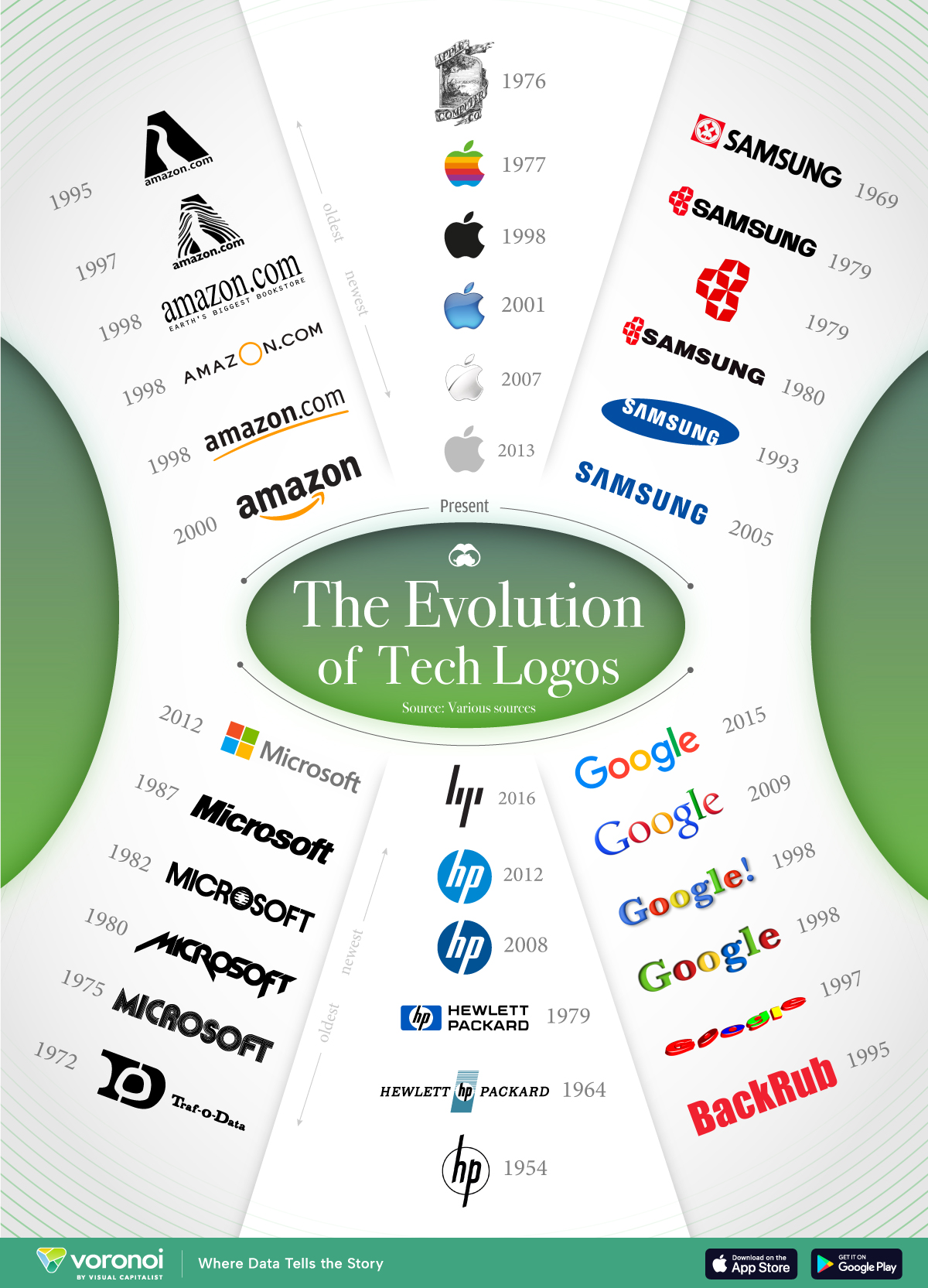Technology
The Future of Military Technology is Intense
Railguns sound like they’re straight out of a Schwarzenegger action movie.
Well, they are – but the reality is that railguns, along with other high-tech weapons such as lasers or hypersonic weapons, are already here.
The U.S. military has actually been testing lasers and railguns for some time, and has now started to mount 30-kW infrared solid-state laser systems on aircraft and gunships. Lockheed has also signed a $147 million contract to build hypersonic weapons that will fire at Mach 20, intercepting targets in under an hour using pure kinetic force.
Visualizing the Future of Military Technology
Today’s infographic comes from Futurism, showing the technological advancements we can expect to materialize in the battlefield over the coming decades.

The future of military technology is here, and it seems to borrow ideas right out of well-known movies such as Star Trek or Eraser.
Here’s the scoop on the advanced weapons systems of tomorrow:
Lasers: The military refers to these as directed-energy weapons (DEWs), and they are exactly what they sound like – lasers that emit highly focused energy to damage or incapacitate a target. In development for 20 roughly years, the circumstances seem to be more promising than ever for DEWs. The need is there, as targets such as groups of small drones could become common in the future. Meanwhile, the technology has finally caught up to the concept – using fiber instead of chemicals means military lasers can be smaller and more powerful.
Railguns: Electromagnetic railguns can fire projectiles at a speed of 4,600 mph (Mach 6). These projectiles use no explosive warheads or payloads, relying solely on extreme kinetic force to damage a target. Current ships, such as the Zumwalt-class destroyers are being designed to accommodate these weapons, and they could also be potentially scaled down for use in tanks.
Hypersonic weapons: Launched from land, sea, or air, hypersonic weapons are intended to be used for first strike applications, hitting targets in under an hour. Using Tactical Boost Glide (TBG) technology, hypersonic weapons are boosted to very high altitudes, where they are then accelerated to speeds of 21,000 mph (Mach 20). It should be noted that China and Russia are both also testing similar weapons systems.
Brands
How Tech Logos Have Evolved Over Time
From complete overhauls to more subtle tweaks, these tech logos have had quite a journey. Featuring: Google, Apple, and more.

How Tech Logos Have Evolved Over Time
This was originally posted on our Voronoi app. Download the app for free on iOS or Android and discover incredible data-driven charts from a variety of trusted sources.
One would be hard-pressed to find a company that has never changed its logo. Granted, some brands—like Rolex, IBM, and Coca-Cola—tend to just have more minimalistic updates. But other companies undergo an entire identity change, thus necessitating a full overhaul.
In this graphic, we visualized the evolution of prominent tech companies’ logos over time. All of these brands ranked highly in a Q1 2024 YouGov study of America’s most famous tech brands. The logo changes are sourced from 1000logos.net.
How Many Times Has Google Changed Its Logo?
Google and Facebook share a 98% fame rating according to YouGov. But while Facebook’s rise was captured in The Social Network (2010), Google’s history tends to be a little less lionized in popular culture.
For example, Google was initially called “Backrub” because it analyzed “back links” to understand how important a website was. Since its founding, Google has undergone eight logo changes, finally settling on its current one in 2015.
| Company | Number of Logo Changes |
|---|---|
| 8 | |
| HP | 8 |
| Amazon | 6 |
| Microsoft | 6 |
| Samsung | 6 |
| Apple | 5* |
Note: *Includes color changes. Source: 1000Logos.net
Another fun origin story is Microsoft, which started off as Traf-O-Data, a traffic counter reading company that generated reports for traffic engineers. By 1975, the company was renamed. But it wasn’t until 2012 that Microsoft put the iconic Windows logo—still the most popular desktop operating system—alongside its name.
And then there’s Samsung, which started as a grocery trading store in 1938. Its pivot to electronics started in the 1970s with black and white television sets. For 55 years, the company kept some form of stars from its first logo, until 1993, when the iconic encircled blue Samsung logo debuted.
Finally, Apple’s first logo in 1976 featured Isaac Newton reading under a tree—moments before an apple fell on his head. Two years later, the iconic bitten apple logo would be designed at Steve Jobs’ behest, and it would take another two decades for it to go monochrome.
-

 Green1 week ago
Green1 week agoRanked: The Countries With the Most Air Pollution in 2023
-

 Automotive2 weeks ago
Automotive2 weeks agoAlmost Every EV Stock is Down After Q1 2024
-

 AI2 weeks ago
AI2 weeks agoThe Stock Performance of U.S. Chipmakers So Far in 2024
-

 Markets2 weeks ago
Markets2 weeks agoCharted: Big Four Market Share by S&P 500 Audits
-

 Real Estate2 weeks ago
Real Estate2 weeks agoRanked: The Most Valuable Housing Markets in America
-

 Money2 weeks ago
Money2 weeks agoWhich States Have the Highest Minimum Wage in America?
-

 AI2 weeks ago
AI2 weeks agoRanked: Semiconductor Companies by Industry Revenue Share
-

 Travel2 weeks ago
Travel2 weeks agoRanked: The World’s Top Flight Routes, by Revenue




